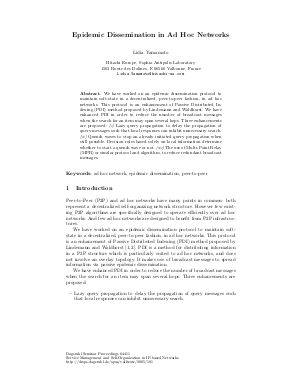Epidemic Dissemination in Ad Hoc Networks
Author Lidia Yamamoto
-
Part of:
Volume:
Dagstuhl Seminar Proceedings, Volume 4411
Part of: Series: Dagstuhl Seminar Proceedings (DagSemProc) - License:
 Creative Commons Attribution 4.0 International license
Creative Commons Attribution 4.0 International license
- Publication Date: 2005-03-24
File

PDF
DagSemProc.04411.11.pdf
- Filesize: 145 kB
- 8 pages
Document Identifiers
Subject Classification
Keywords
- ad hoc networks
- epidemic dissemination
- peer-to-peer
Metrics
- Access Statistics
-
Total Accesses (updated on a weekly basis)
0Document
0Metadata
Abstract
Peer-to-Peer (P2P) and ad hoc networks have many points in common: both represent a decentralized self-organizing network structure. However few existing P2P algorithms are specifically designed to operate efficiently over ad hoc networks. And few ad hoc networks are designed to benefit from P2P infrastructures. We have worked on an epidemic dissemination protocol to maintain soft-state in a decentralized, peer-to-peer fashion, in ad hoc networks. This protocol is an enhancement of Passive Distributed Indexing (PDI) method proposed by Lindemann and Waldhorst. PDI is a method for distributing information in a P2P structure which is particularly suited to ad hoc networks, and does not involve an overlay topology. It makes use of broadcast messages to spread information via passive epidemic dissemination. We have enhanced PDI in order to reduce the number of broadcast messages when the search for an item may span several hops. Three enhancements are proposed: 1) Lazy query propagation to delay the propagation of query messages such that local responses can inhibit unnecessary search. 2) Quench waves to stop an already initiated query propagation when still possible. A decision algorithm determines whether to start a quench wave or not based solely on local information. 3) The use of Multi-Point Relay (MPR) or similar protocol and algorithm, to reduce redundant broadcast messages. This talk will present the current state of this research, and discuss several open aspects with the purpose of stimulating debate. The talk will also include an overview of related work such as epidemic models from biology, other epidemic protocols for P2P overlays and MANETs, including gossip (active) and promiscuous (passive) dissemination modes. Such protocols could be used for many different purposes, roughly any task requiring distributed soft-state maintenance in the ad hoc network, including DNS and identifier mappings, network monitoring and configuration, and so on. During the talk we will also exploit the possibility of using the protocol to disseminate service information for on-demand service deployment, and further, to assist in self-composing protocol structures.
Cite As Get BibTex
Lidia Yamamoto. Epidemic Dissemination in Ad Hoc Networks. In Service Management and Self-Organization in IP-based Networks. Dagstuhl Seminar Proceedings, Volume 4411, pp. 1-8, Schloss Dagstuhl – Leibniz-Zentrum für Informatik (2005)
https://doi.org/10.4230/DagSemProc.04411.11
BibTex
@InProceedings{yamamoto:DagSemProc.04411.11,
author = {Yamamoto, Lidia},
title = {{Epidemic Dissemination in Ad Hoc Networks}},
booktitle = {Service Management and Self-Organization in IP-based Networks},
pages = {1--8},
series = {Dagstuhl Seminar Proceedings (DagSemProc)},
ISSN = {1862-4405},
year = {2005},
volume = {4411},
editor = {Matthias Bossardt and Georg Carle and D. Hutchison and Hermann de Meer and Bernhard Plattner},
publisher = {Schloss Dagstuhl -- Leibniz-Zentrum f{\"u}r Informatik},
address = {Dagstuhl, Germany},
URL = {https://drops.dagstuhl.de/entities/document/10.4230/DagSemProc.04411.11},
URN = {urn:nbn:de:0030-drops-1013},
doi = {10.4230/DagSemProc.04411.11},
annote = {Keywords: ad hoc networks , epidemic dissemination , peer-to-peer}
}
